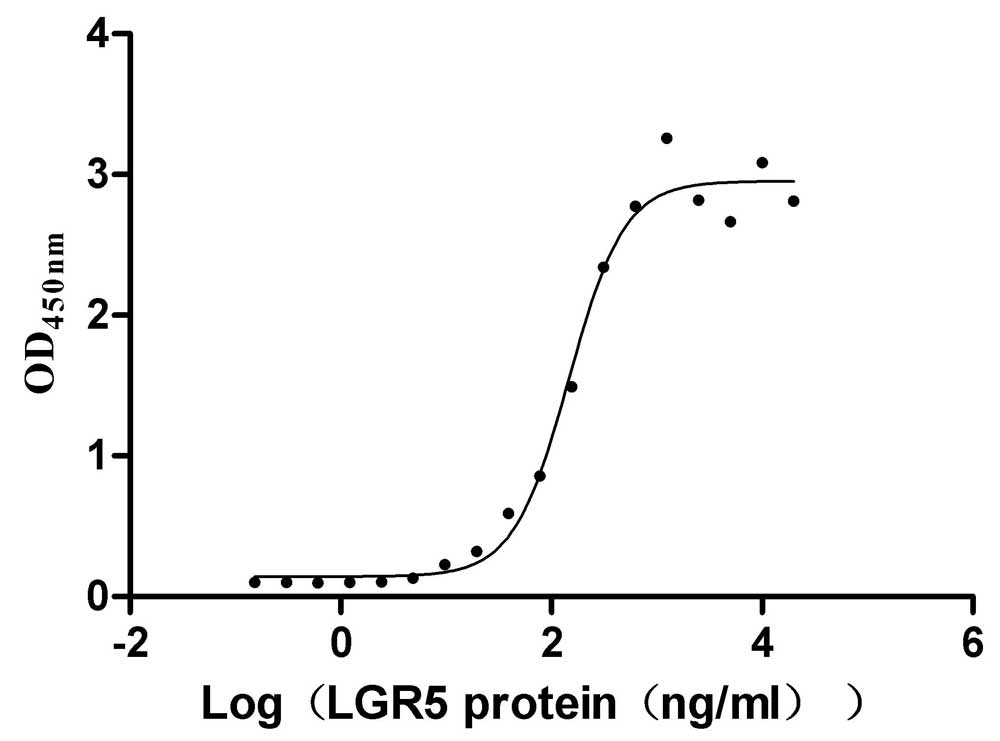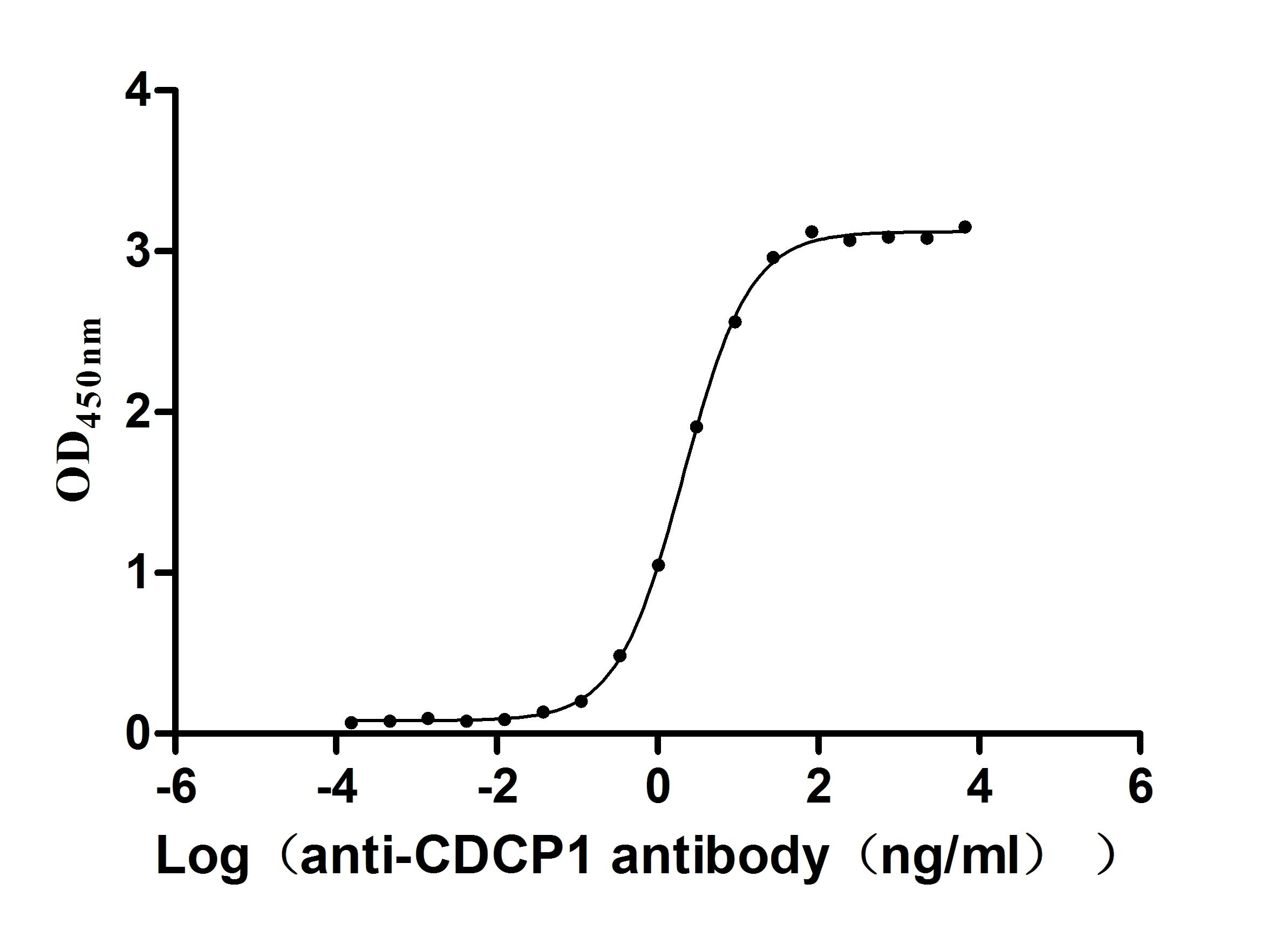Recombinant Mouse Very long-chain acyl-CoA synthetase (Slc27a2), partial
-
中文名称:小鼠Slc27a2重组蛋白
-
货号:CSB-YP021534MO1
-
规格:
-
来源:Yeast
-
其他:
-
中文名称:小鼠Slc27a2重组蛋白
-
货号:CSB-EP021534MO1
-
规格:
-
来源:E.coli
-
其他:
-
中文名称:小鼠Slc27a2重组蛋白
-
货号:CSB-EP021534MO1-B
-
规格:
-
来源:E.coli
-
共轭:Avi-tag Biotinylated
E. coli biotin ligase (BirA) is highly specific in covalently attaching biotin to the 15 amino acid AviTag peptide. This recombinant protein was biotinylated in vivo by AviTag-BirA technology, which method is BriA catalyzes amide linkage between the biotin and the specific lysine of the AviTag.
-
其他:
-
中文名称:小鼠Slc27a2重组蛋白
-
货号:CSB-BP021534MO1
-
规格:
-
来源:Baculovirus
-
其他:
-
中文名称:小鼠Slc27a2重组蛋白
-
货号:CSB-MP021534MO1
-
规格:
-
来源:Mammalian cell
-
其他:
产品详情
-
纯度:>85% (SDS-PAGE)
-
基因名:
-
Uniprot No.:
-
别名:Slc27a2; Acsvl1; Facvl1; Fatp2; Vlacs; Vlcs; Very long-chain acyl-CoA synthetase; VLACS; VLCS; Arachidonate--CoA ligase; Fatty acid transport protein 2; FATP-2; Fatty-acid-coenzyme A ligase, very long-chain 1; Long-chain-fatty-acid--CoA ligase; Phytanate--CoA ligase; Solute carrier family 27 member 2; THCA-CoA ligase; Very long-chain-fatty-acid-CoA ligase
-
种属:Mus musculus (Mouse)
-
蛋白长度:Partial
-
蛋白标签:Tag type will be determined during the manufacturing process.
The tag type will be determined during production process. If you have specified tag type, please tell us and we will develop the specified tag preferentially. -
产品提供形式:Lyophilized powder
Note: We will preferentially ship the format that we have in stock, however, if you have any special requirement for the format, please remark your requirement when placing the order, we will prepare according to your demand. -
复溶:We recommend that this vial be briefly centrifuged prior to opening to bring the contents to the bottom. Please reconstitute protein in deionized sterile water to a concentration of 0.1-1.0 mg/mL.We recommend to add 5-50% of glycerol (final concentration) and aliquot for long-term storage at -20℃/-80℃. Our default final concentration of glycerol is 50%. Customers could use it as reference.
-
储存条件:Store at -20°C/-80°C upon receipt, aliquoting is necessary for mutiple use. Avoid repeated freeze-thaw cycles.
-
保质期:The shelf life is related to many factors, storage state, buffer ingredients, storage temperature and the stability of the protein itself.
Generally, the shelf life of liquid form is 6 months at -20°C/-80°C. The shelf life of lyophilized form is 12 months at -20°C/-80°C. -
货期:Delivery time may differ from different purchasing way or location, please kindly consult your local distributors for specific delivery time.Note: All of our proteins are default shipped with normal blue ice packs, if you request to ship with dry ice, please communicate with us in advance and extra fees will be charged.
-
注意事项:Repeated freezing and thawing is not recommended. Store working aliquots at 4°C for up to one week.
-
Datasheet :Please contact us to get it.
相关产品
靶点详情
-
功能:Acyl CoA synthetase that activates long-chain and very long-chain fatty acids (VLCFAs) by catalyzing the formation of fatty acyl-CoA. Can also activate branched-chain fatty acids such as phytanic acid and pristanic acid. Does not activate C24 bile acids, cholate and chenodeoxycholate. In vitro, activates 3-alpha,7-alpha,12-alpha-trihydroxy- 5-beta-cholestanate (THCA), the C27 precursor of cholic acid deriving from the de novo synthesis from cholesterol. Exhibits long-chain fatty acids (LCFA) transport activity and plays an important role in hepatic fatty acid uptake.
-
基因功能参考文献:
- Contractile strength in FATP2-knockdown gallbladders was significantly greater than in control gallbladders following lithogenic diet administration. FATP2-knockdown significantly reduced gallbladder triacylglycerol. PMID: 27033116
- In mice Grassofermata decreased absorption of (13)C-oleate demonstrating its potential as a therapeutic agent. PMID: 26284975
- even though hypoxia regulates the expression of FATP2 and FATP4 in human trophoblasts, mouse Fatp2 and Fatp4 are not essential for intrauterine fetal growth PMID: 22028793
- FATP2 is a multifunctional protein that shows subcellular localization-dependent activity and is a major contributor ro peroxisomal (V)LACS activity. PMID: 20530735
- mouse VLCS gene (Vlcs) encodes an enzyme (Vlcs) with VLCS activity that localizes to peroxisomes and is expressed in X-ALD target tissues PMID: 12048192
- PPARalpha up-regulates the expression of Slc27a2 in small intestine. PMID: 17978498
显示更多
收起更多
-
亚细胞定位:Endoplasmic reticulum membrane; Multi-pass membrane protein. Peroxisome membrane; Peripheral membrane protein. Cell membrane; Multi-pass membrane protein. Microsome.
-
蛋白家族:ATP-dependent AMP-binding enzyme family
-
组织特异性:Strong expression in liver and kidney (at protein level). Lower expression in brain and testis, no expression in skeletal muscle and spleen. Shows uniform distribution in liver acinus.
-
数据库链接:
KEGG: mmu:26458
STRING: 10090.ENSMUSP00000057595
UniGene: Mm.290044
Most popular with customers
-
Recombinant Human Receptor tyrosine-protein kinase erbB-3 (ERBB3), partial (Active)
Express system: Mammalian cell
Species: Homo sapiens (Human)
-
Recombinant Human R-spondin-1 (RSPO1), partial (Active)
Express system: Mammalian cell
Species: Homo sapiens (Human)
-
Recombinant Human Cannabinoid receptor 1 (CNR1)-VLPs (Active)
Express system: Mammalian cell
Species: Homo sapiens (Human)
-
Recombinant Dog B-lymphocyte antigen CD20 (MS4A1)-VLPs (Active)
Express system: Mammalian cell
Species: Canis lupus familiaris (Dog) (Canis familiaris)
-
Recombinant Human Glucagon-like peptide 1 receptor (GLP1R), partial (Active)
Express system: Mammalian cell
Species: Homo sapiens (Human)
-
Recombinant Human Desmoglein-3 (DSG3), partial (Active)
Express system: Baculovirus
Species: Homo sapiens (Human)
-
Recombinant Macaca fascicularis CUB domain containing protein 1 (CDCP1), partial (Active)
Express system: Mammalian cell
Species: Macaca fascicularis (Crab-eating macaque) (Cynomolgus monkey)
-
Recombinant Human Interleukin-1 receptor accessory protein (IL1RAP), partial (Active)
Express system: Mammalian cell
Species: Homo sapiens (Human)




















